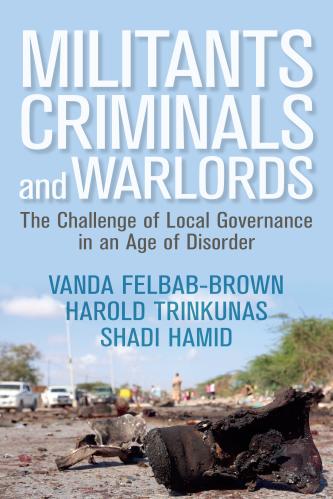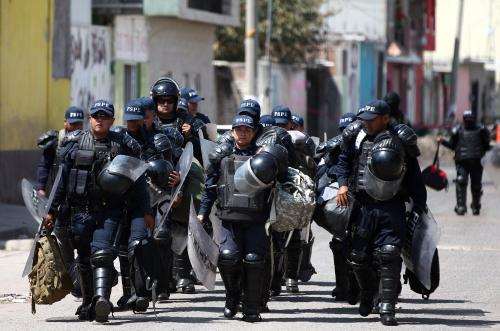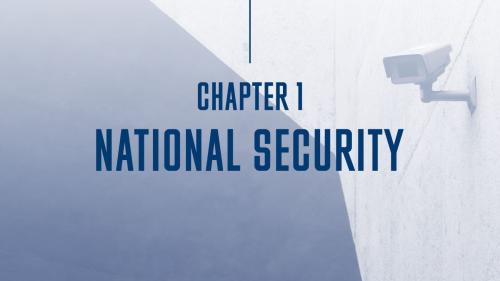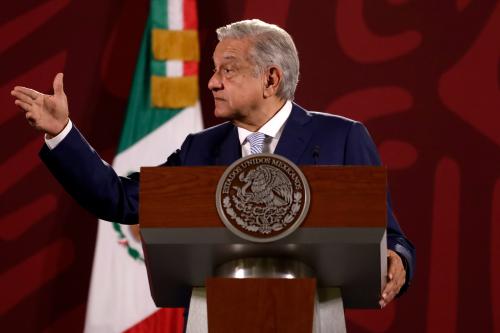Following what appears to be the Andrés Manuel López Obrador administration’s decision to quietly reinitiate targeting drug traffickers in Mexico, Vanda Felbab-Brown explains that merely returning to opportunistic, non-strategic high-value targeting of top traffickers that characterized the Felipe Calderón and Enrique Peña Nieto era, instead of systematically dismantling the operational capacities of criminal groups, will be as problematic now as then. This post originally appeared in Mexico Today.
Over the past several weeks, the AMLO administration appears to have quietly reinitiated targeting drug traffickers, at least to some extent. Systematically going after drug trafficking and criminal organizations is important, necessary, and correct. But how the effort against criminal groups is designed matters tremendously. Merely returning to opportunistic, non-strategic high-value targeting of top traffickers that characterized the Felipe Calderón and Enrique Peña Nieto era, instead of systematically dismantling the operational capacities of criminal groups, will be as problematic now as then. And such a policy will be as inadequate as AMLO’s ‘hugs, not bullets’ approach so far.
During his first year in office President Andres Manuel Lopez Obrador flatly refused to go after criminal groups and suspended many interdiction operations. Instead, he has sought to reduce crime by addressing what his administration identified as its underlying causes: poverty and socio-economic exclusion.
However, since the start of the year, a number of high-profile arrests of crime bosses took place in Mexico. Many of those operations have been conducted by SEMAR, the preferred U.S. anti-crime partner in Mexico. Though considered far more competent and far less corrupt than other Mexican agencies by the United States, SEMAR was shunned by the AMLO administration during its first year. This resurrection of targeting leaders of criminal groups comes on the heels of the intense U.S. pressure on Mexico after the cartel murders of the LeBaron family in November 2019. Trump’s threat to designate Mexican criminal organizations as terrorist groups was the most bombastic salvo of that pressure.
U.S. blaster apart, the slaughter of the LeBaron family was, in fact, the last straw in a year of terrible security incidents in Mexico. They included continual attacks on police stations and businesses by ultra-aggressive criminal groups like the Cartel Jalisco Nueva Generación, the burning of 31 people in a Veracruz casino, and, of course, the Sinaloa Cartel temporary takeover of the city of Culiacán to liberate El Chapo’s son Ovidio Guzmán Lopez. Each of these incidents further eviscerated the already collapsed deterrence capacity of Mexican law enforcement agencies. Each should have been enough to shake up to the AMLO administration out of its dogged rejection of a central meaningful law enforcement approach going beyond the re-invention and renaming of institutions such as the National Guard.
A well-designed law enforcement strategy that targets key perpetrators, such as the most violent groups, is a vital and inescapable component of dealing with crime. Socio-economic anti-crime policies are a critical component of a well-designed anti-crime strategy. But they are just one element, inadequate without a robust well-thought-through law enforcement component.
But a return to non-strategic decapitation policies of the past decade and half will only exacerbate many of Mexico’s security problems, including constant fragmentation of criminal groups and the collapse of their own deterrence capacity against rival groups. Amplifying the collapse of deterrence by Mexico’s law enforcement, such lack of balances of power in the criminal market feeds violent mayhem.
Mexico must avoid the spasmatic oscillation between opportunistic high-value-targeting and giving up on meaningful law enforcement. Instead, with U.S. help, it needs to design law enforcement efforts to stabilize a particular area and gradually expand the area of stability –though robust strategic intelligence, targeting the middle layer of criminal groups, and the establishment of effective local policing and local deterrence capacities.







Commentary
Mexico needs better law enforcement, but the solution isn’t opportunistic decapitation
February 14, 2020